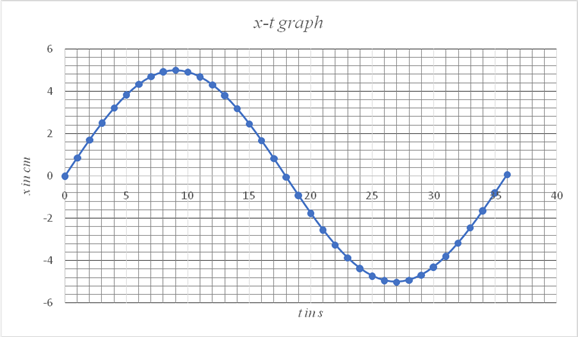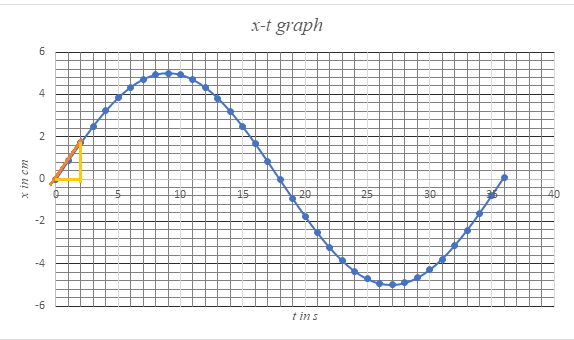
Concept explainers
(a)
To plot:The position x of a body oscillating on a spring as a function of time.
(a)
Explanation of Solution
Given:
The equation of position x as a function of time
The values of the constants
The time interval
Calculation:
Using the given values of the variables in the given equation,
On a spreadsheet calculate the values of the position with respect to time and plot a graph as shown.
| t in s | x in cm |
| 0 | 0 |
| 1 | 0.87054 |
| 2 | 1.71449 |
| 3 | 2.50607 |
| 4 | 3.22109 |
| 5 | 3.83772 |
| 6 | 4.33712 |
| 7 | 4.70403 |
| 8 | 4.92725 |
| 9 | 4.99996 |
| 10 | 4.91993 |
| 11 | 4.68961 |
| 12 | 4.31605 |
| 13 | 3.81064 |
| 14 | 3.18882 |
| 15 | 2.4696 |
| 16 | 1.67494 |
| 17 | 0.82912 |
| 18 | -0.042 |
| 19 | -0.9119 |
| 20 | -1.7539 |
| 21 | -2.5424 |
| 22 | -3.2531 |
| 23 | -3.8645 |
| 24 | -4.3579 |
| 25 | -4.7181 |
| 26 | -4.9342 |
| 27 | -4.9996 |
| 28 | -4.9123 |
| 29 | -4.6749 |
| 30 | -4.2947 |
| 31 | -3.7833 |
| 32 | -3.1563 |
| 33 | -2.433 |
| 34 | -1.6353 |
| 35 | -0.7876 |
| 36 | 0.08407 |

Figure 1
Conclusion:
Thus, the position x of the object which undergoes oscillation following the equation
(b)
To measure:The slope of the
(b)
Answer to Problem 114P
The velocity of the object at time
Explanation of Solution
Given:
The
Calculation:
Draw a tangent to the curve at time

Figure 2
From Figure 2, the slope of the tangent (drawn in red) is given by,
Hence the velocity of the object at time
Conclusion:
Thus, the velocity of the object at time
(c)
To calculate:The average velocity for a series of intervals starting from
(c)
Answer to Problem 114P
The average velocities for the time intervals starting at
Explanation of Solution
Given:
The equation for the position of the oscillating particle
The times at which the average velocity is determined
Formula used:
The average velocity of a particle is the rate of change of position of the object during the time interval.
Calculation:
Determine the value of the position of the object
Determine the position of the particle at time
Determine the average velocity for the time interval
Find the position of the particle at time
Determine the average velocity for the time interval
Find the position of the particle at time
Determine the average velocity for the time interval
Find the position of the particle at time
Determine the average velocity for the time interval
Find the position of the particle at time
Determine the average velocity for the time interval
Find the position of the particle at time
Determine the average velocity for the time interval
Conclusion:
Thus, the average velocities for the time intervals starting at
(d)
To compute:
(d)
Answer to Problem 114P
The value of
Explanation of Solution
Given:
The equation for the position of the oscillating particle
Formula used:
The velocity of a particle is the first derivative of the position with respect to time and is given by,
Calculation:
Differentiate the given equation with respect to time.
Substitute
Conclusion:
The value of
(e)
To compare: the results of parts (c) and (d) and explain why the part(c) results approach part (d) result.
(e)
Explanation of Solution
Given:
Results of part (c)
The average velocities of the particle for the time intervals starting at
are as follows:
| Time interval(s) | Average velocity (cm/s) |
| 0-6.0 | 0.72 |
| 0-3.0 | 0.86 |
| 0-2.0 | 0.86 |
| 0-1.0 | 0.87 |
| 0-0.50 | 0.87 |
| 0.25 | 0.87 |
Results of part (d)
The instantaneous velocity of the particle at time
Introduction:
Average velocity is defined as the ratio of change in position to the time interval.
The instantaneous velocity is given by,
As the measured time interval becomes smaller, the average velocity approaches the instantaneous velocity. For a large time interval such as
Conclusion:
Thus, it can be seen that as th magnitude of the measured time intervals decrease, the values of the average velocities approach the value of instantaneous velocity.
Want to see more full solutions like this?
Chapter 2 Solutions
SAPLING PHYS SCIEN&ENG W/MULTITERM ACCE
- A student is asked to measure the acceleration of a glider on a frictionless, inclined plane, using an air track, a stopwatch, and a meterstick. The top of the track is measured to be 1.774 cm higher than the bottom of the track, and the length of the track is d = 127.1 cm. The cart is released from rest at the top of the incline, taken as x = 0, and its position x along the incline is measured as a function of time. For x values of 10.0 cm, 20.0 cm, 35.0 cm, 50.0 cm, 75.0 cm, and 100 cm, the measured times at which these positions are reached (averaged over five runs) are 1.02 s, 1.53 s, 2.01 s, 2.64 s, 3.30 s, and 3.75 s, respectively. (a) Construct a graph of x versus t2, with a best-fit straight line to describe the data. (b) Determine the acceleration of the cart from the slope of this graph. (c) Explain how your answer to part (b) compares with the theoretical value you calculate using a = g sin as derived in Example 4.3.arrow_forwardThe coordinates of a particle’s motion are sinusoidal over time. Which of the following best describes the particle’s motion? constant translational motion zero acceleration motion projectile motion uniform circular motionarrow_forwardAt t = 0, a particle leaves the origin with a velocity of 9.0 m/s in the positive y direction and moves in the xyplane with a constant acceleration of (2.0i −4.0j) m/s2. At the instant the x coordinate of the particle is 15 m, what is the speed of the particle (in m/s)?arrow_forward
- When will the particle reach constant velocity given the position versus time curve equation of x = t^3-6t^2+5? (in sec)arrow_forwardThe motion of a vibrating particle is defined by the position vector r = 10(1 − e−3t)i + (4e−2tsin 15t)j, where r and t are expressed in millimeters and seconds, respectively. Determine the velocity and acceleration when t = 0. When t = 0, the velocity is ____mm/s ∡ 63.4° and the acceleration is ____mm/s2 ⦫ _____°.arrow_forwardA wind tunnel test reveals that the acceleration of a racing car from rest can bemodeled by the equationa = 25 – 3s2Find(a) The velocity of the car when its displacement is 2 m;(b) The displacement when the velocity is again zero; and(c) The displacement when the velocity is a maximum.arrow_forward
- For a short time, the path of the plane in the figure is described by y = (0.001x^2) m. If the plane is rising with a constant velocity of 10 m/s, determine the magnitudes of the velocity and acceleration of the plane when it is at y = 100 m.arrow_forward. A motorbike starts from the origin and moves in an xy plane with accelerationcomponents ax = 6.0 m/s2 and ay = -3.0 m/s2. The initial velocity of the motorbike hascomponents v0x = 12.0 m/s and v0y = 18.0 m/s. Find the velocity of the motorbike, in unitvector notation, when it reaches the maximum y positionarrow_forwardYou drop a stone down a well that is 9.5 m deep. How long is it before you hear the splash? The speed of sound in air is 343 m/s and air resistance is negligible. A) 1.4 s B) 1.6 s C) 1.3 s D) 1.2 s E) 1.5 sarrow_forward
- The displacement of an object is described by the following equation, where x is in meters and t is in seconds. Given: x(t)=30.0m cos6.0t calculate the 1)period of the displacement 2)maximum accelerationarrow_forwardA particle is fired vertically upwards and its height, h metres, after any number of seconds, t, is given by formula h=50t-2t2 a) Find the height of particle after 2.3 seconds b) Find the speed of particle after 2.7 seconds c) What does dh/dt=0 mean in the context of the question? d) After how many seconds does the particle stop rising?arrow_forwardTwo masses hanging side by side from springs have positionss1 = 2 sin t and s2 = sin 2t, respectively. At what times in the interval 0 < t do the masses pass eachother?arrow_forward
 Principles of Physics: A Calculus-Based TextPhysicsISBN:9781133104261Author:Raymond A. Serway, John W. JewettPublisher:Cengage Learning
Principles of Physics: A Calculus-Based TextPhysicsISBN:9781133104261Author:Raymond A. Serway, John W. JewettPublisher:Cengage Learning Glencoe Physics: Principles and Problems, Student...PhysicsISBN:9780078807213Author:Paul W. ZitzewitzPublisher:Glencoe/McGraw-Hill
Glencoe Physics: Principles and Problems, Student...PhysicsISBN:9780078807213Author:Paul W. ZitzewitzPublisher:Glencoe/McGraw-Hill Classical Dynamics of Particles and SystemsPhysicsISBN:9780534408961Author:Stephen T. Thornton, Jerry B. MarionPublisher:Cengage Learning
Classical Dynamics of Particles and SystemsPhysicsISBN:9780534408961Author:Stephen T. Thornton, Jerry B. MarionPublisher:Cengage Learning


